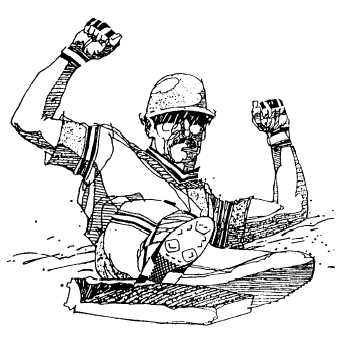| |
ICE AND SNOW SPORTS
Ice and snow sports can be fun but deadly. In
addition to the stresses placed on the body, there is the
added hazard of extreme cold. Winter sports include the
following activities:
Ice skating
Sledding, tobogganing, and snow disk riding
Snowmobiling
Skiing
Of these winter sports, Navy personnel experience
the most mishaps from snow skiing. Each year
thousands of people suffer injuries in skiing accidents.
From 1984 to 1992, more than 150 Navy people have
been hurt in mishaps on ski slopes and trails. One of
these mishaps resulted in a fatality when a skier lost
control in icy conditions and crashed into a tree. Another
person suffered a permanent disability when he
fractured a vertebrae in his lower back. Fortunately,
most injuries are less severe, with broken legs and knee
injuries commonly reported. You can still get hurt while
cross-country skiing even though it is slower than
downhill skiing.
The most common cause of skiing accidents is
inexperience. Beginners hurt themselves when they try
to move from a beginner’s slope to advanced or expert
slopes too soon. Trying slopes that are too steep or icy
can result in injuries to even the more experienced
skiers. The buildup of too much speed can cause you to
lose control.
SAFETY FOR ATHLETIC ACTIVITIES
People take part in many sports and other athletic
activities both as members of on- and off-base teams.
Intramural sports are part of the total recreation
program. Athletics provide a basic physical con-
ditioning process through which the Navy can help build
and maintain an effective fighting force.
Some athletic events have inherent risks for
participants. Padding and protective equipment can help
reduce injuries and are mandatory for some sponsored
team events. A good athlete is familiar with the injury
potential of the sport being played and knows how to
avoid injuries. When you are injured, you are of little
use to a team. Part of the skill of any sport is the ability
of an athlete to avoid injury.
One factor repeatedly cited as a major contributor
to a mishap involving physical fitness is overexertion.
Once people realize they are out of shape, they want to
do something about it. Unfortunately, they usually try to
get back into shape too fast. Age has nothing to do with
deaths relating to overexertion while exercising.
Anyone is subject to overexertion, regardless of age or
physical conditioning. With today’s emphasis on health
and wellness, many people take up strenuous fitness
activities before they condition their bodies.
Good physical fitness can pay off, if you do it
carefully and consistently. However, strenuous exercise
once a week can do more damage than good. Before you
start any physical fitness program, check with your
doctor. The doctor will determine what precautions you
should take and if you need a complete physical exam.
Checking with your doctor is especially important if you
are more than 35 years old.
Baseball and Softball
Since baseball and softball present similar hazards,
you should take similar precautions to avoid injury. The
most serious mishaps associated with baseball and
softball are those resulting from sliding and collisions.
Breakaway bases are much safer than stationary bases.
Softball fields operated by MWR departments are being
converted from stationary to breakaway bases. Until the
MWR installs breakaway bases, your command should
conduct a sliding clinic. Establish a no-sliding rule for
command-sponsored picnic and pickup games to
prevent personnel from breaking their ankles and legs.
Establish a no-sliding rule.
11-9
|

